when an electromagnet has an iron core inserted, what happens to the strength of the magnet?



Experiments with electromagnets
DC Electromagnets
Clarification:
A DC electromagnet is only a ringlet of wire connected to a DC voltage source. It tin have an air core or an iron core.
Construction: ![]()
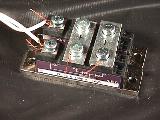
The construction would be the same as the AC electromagnet. The difference would be that instead of connecting information technology directly to the output of a variac, connect the output of the variac to a diode bridge (shown in the photograph), and connect the coil to the DC output terminals of the diode bridge. To smooth out the DC output, a capacitor tin can be continued in parallel with the coil.
Demonstration:
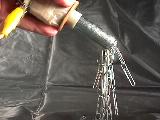
Information technology can exist shown how the DC electromagnet will pick up several paper clips. Adjacent, plough the variac down to cipher, to show how nigh of the newspaper clips autumn off the cease of the bolt. There may be a couple that hang on.
Conclusions:
It behaves like a permanent magnet as long as at that place is power practical to it. Information technology'southward a magnet that tin can be turned on and off, and its magnetic strength can be varied every bit the voltage to it is varied. In fact, for the aforementioned voltage out of the variac, there volition be more electric current flowing in the DC electromagnet than the Ac electromagnet (no inductive reactance in the circuit), so it volition exist a stronger magnet!
The polarity of the magnetic pole at the end of the bolt does not change like the AC electromagnet does. It volition be either a North or a South magnetic pole, depending on how it is connected to the output of the diode bridge.
For a faux diagram of the field effectually this electromagnet without an iron core, expect here.
For a faux diagram of the field around this electromagnet with an iron core, expect here.
An Easy Electromagnet Experiment ![]()
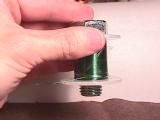
Making an electromagnet isn't hard, but understanding all of the variables involved can seem a bit overwhelming the commencement couple of times. Hither'south an experiment that's easy to make and do some measurements.
What you'll need are the post-obit:
Set up of magnet wire spools (Radio Shack p/northward 278-1345B)
200' of 30 AWG wire
75' of 26 AWG wire
40' of 22 AWG wire
Steel commodities, �-thirteen thread, 2" long
Estimator power supply, 5V, proficient for 8A or more, or a big 6V lantern battery
Sandpaper, 100 to 200 grit, 2" square
BB's, 3000 steel BB'due south in a plastic bowl
The steel bolt tin exist obtained from near hardware stores. The sandpaper tin be picked upward there, too.
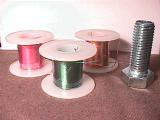
Computer ability supplies, similar those used for tower computers, are usually rated between 140W to 250W. They supply 5V at 8A or more than, as well as +12V and –12V and -5V at much lower currents. Nosotros will want to apply the 5V supply since that works much better than a battery. If you don't have one, become to a calculator store and ask if they have one that is broken, just the 5V supply still works. I got one for free that style. A new i is fine, but costs more. The +5V is usually the red wire. Find a connector with three of them and utilise all three in parallel for your supply. On the same connector should be two or three black wires as the common. Employ them in parallel for your other connectedness. (+12V is usually the yellow wire, -12V is ordinarily blueish, and -v is often white: don't apply them.) If you want, you could utilise a 6V lantern battery, like the ane pictured hither. A smaller size bombardment will non be able to supply the electric current and will last for only a curt time.
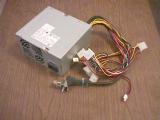
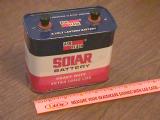
BB's are steel balls about 4.5mm (0.177") in bore that are used with BB guns. I bought a bunch of them at a sporting goods store. When you go, take a magnet with y'all to make sure that they are made of steel.
At that place are three primal items that impact the design of an electromagnet, and each of them have several sub-items that need to be considered. They are the roll, the cadre, and the power source. Let'southward look at each one.
1. The curl
-
The diameter or estimate of the wire used for the coil.
-
The length of the wire used for the ringlet.
-
The number of turns of wire effectually the core.
The above parameters affect the dimensions of the coil: its inside diameter, outside diameter, and length. These dimensions, along with the size of wire used, determines the length of wire needed and the resistance of the wire.
2. The core
-
The size of the core.
-
The material used for the cadre.
Is the core going to be air, or volition it be steel? Will the steel be laminated or solid? What shape will it have?
iii. The ability source
- The voltage powering the roll.
- The frequency of the voltage powering the gyre
Is the ability source DC or Air conditioning? If Ac, what is the frequency? What is the duty cycle (how long is it on versus how long is it off)?
Why do all of these things touch on the strength of the electromagnet? Because the one particular that has the biggest result is called the Ampere-turns. This is merely the number of amps of current flowing in the wire of the curlicue multiplied by the number of turns of wire in that location are around the core. And so, length of the wire, its bore, the size of the winding, and the source all affect either the amps that will menses or the number of turns that be or both.
Let's see how this works.
In the packet of magnet wire from Radio Shack, you lot get 3 spools. On one spool is 200 feet of 30 judge of wire. It has a reddish color to it. Information technology'southward resistance is about 20 Ohms. With v Volts on the scroll, the amount of current that would period is equal to the voltage divided by the resistance, or 5/20 = 0.25 Amps. I figured in that location are about 800 turns of wire on the spool. So, the Ampere-turns is 0.twenty*800 = 200. This is saying that the forcefulness of the magnet would be same no matter how yous get the 200 Ampere-turns. For example, you could accept 200 Amps, and 1 turn, or 1Amp and 200 turns, or any other combination. The event would be the same in terms of the overall magnetic field created past this coil.
What happens when we look at the other spools? This table summarizes the data.
| Length, feet | Gauge, AWG | Resistance, Ohms | Voltage | Electric current, I=V/R | Number of turns | Ampere-turns |
| 200 | 30 | 20 | 5 | 0.25 | 800 | 200 |
| 75 | 26 | 3 | 5 | one.67 | 350 | 580 |
| twoscore | 22 | 0.65 | 5 | 7.7 | 160 | 1230 |
This is saying, that for the same voltage connected to each of the coils, the coil using the 30 AWG wire would be able to pick upward a certain number of BB's. The coil using the 26 AWG wire would pick upward about three times as many BB's. And the curl using the 22 AWG wire would choice up about six times as many BB's equally the starting time roll, and 2 times equally many BB's every bit the 2d whorl. Nosotros volition employ picking up BB's as a fashion to compare magnetic field strengths. You could too use paperclips or nails, or staples, just BB's work well and are fairly piece of cake to count.
One other matter nosotros demand to go on in heed. When electric current flows through the wire, it creates heat. Will the coil become likewise hot? Commencement, find out how many watts will be prodigal by the curl. For the third curl in the tabular array above, the watts = I^2 * R = seven.seven*7.7*0.65 = 38 watts. There needs to exist plenty surface expanse and so that the watts/sq.in. is no more than than 0.5. In this case, the watts/sq.in. works out to most 9.5, which is a lot more than 0.v! And so, expect the coil to get hot and don't keep in on continuously. It's OK to run it for 10 seconds, then turn it off for 30 seconds to be able to cool.
Let'south endeavour this out!
Have each roll and clean off well-nigh �" of the varnish on each cease of the wire on each spool. Use the sandpaper to do this. Fold the sandpaper in half and pinch the wire betwixt the newspaper and pull the paper straight off the wire. Later a dozen times, you should start to see the copper color of the wire appear. This is very obvious on the blood-red varnish and the green varnish wire. Information technology's harder to meet on the clear varnish wire. Do this to both ends of the wire on each scroll. One finish sticks out of a small pigsty in the heart of the core. The other end volition demand to exist unwound one plow from the exterior of the curlicue. The reason for this is to exist able to make a good electrical connectedness to the wire.
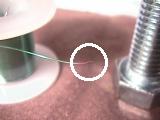
I kept the wire on the spools since it is neatly wound, and the pigsty in the middle of the spool is a good fit for a commodities.
Adjacent, driblet the �" bolt into the heart of the cadre of the spool of 30 AWG wire. This helps to concentrate the lines of magnetic field within the steel bolt instead of letting them disperse in the air.
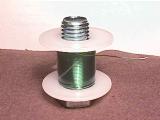
Connect the roll to the 5V power supply. If yous take a multi-meter that can measure the currents we anticipate in the table higher up, connect it between the power supply and the ringlet.
Now, selection up as many steel BB's as possible, and concur them over a divide container, and disconnect the power supply from the gyre, causing the BB's to fall into the separate container. Reconnect the power supply, and once again pick up as many BB's from the start container equally possible, and driblet them into the second container. Practise this for a total of x times. Now, count the number of BB'southward in the second container and divide that number past 10. This volition give you the average number of BB's that electromagnet tin can pick up.
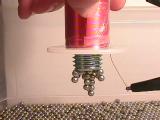
Side by side, exercise the same thing with the 2nd spool of 26 AWG wire. Discover out the average number of BB's it can pick up. Yous will find that this spool of wire will first to get a little warm.
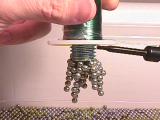
Finally, practice the same thing with the third spool of 22 AWG wire. This spool will get much warmer. If information technology gets too hot to hold, disconnect the power supply from the spool of wire for a few minutes to give it time to absurd off. Once more, your goal is to find out the boilerplate number of BB'south it tin can choice up.
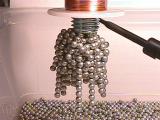
With this data, compare the number of BB'due south using each ringlet. How do the ratios of the numbers compare? Is it shut to what we expected? Were you able to measure out the current? Are they shut to what we expected? If not, what could affect that value?
What else could y'all do? You could air current the wire onto a �" diameter bolt, and become a lot more than turns using the aforementioned length of wire. This would increase the Ampere-turns of the electromagnet. Changing the voltage of the ability supply would besides affect the strength, so, using the 6V battery instead of the 5V power supply means more electric current, and thus more Ampere-turns.
A Pair of Electromagnets on a Yoke ![]()
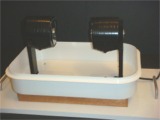
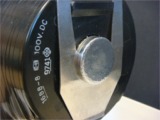
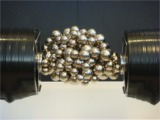
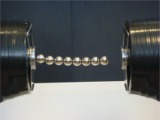
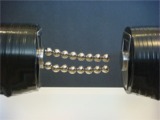
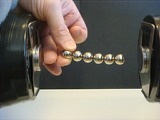
To brand this, I took ii DC electromagnets from a pair of 1000A DC contactors made by Cutler-Hammer. The electromagnets are about 4" in diameter, are iv" long, and have a one" diameter soft atomic number 26 core. I mounted them onto a steel "U" shaped yoke fabricated of 1/2" thick, ii" wide steel, welded together, and bolted to the wooden base. I then put a plastic tray under them, fabricated a Ac/DC 2A supply for them using just a diode bridge fed from the 120V line. This gives united states almost 100Vdc for each electromagnet. They are wired to give a North pole facing a S pole.
When it is turned on, you tin stick a big bunch of steel balls between the two electromagnets. I apply sizes that range from 1/4" to 3/4" to make information technology interesting. The photograph on the right shows how these steel balls are temporary magnets since they human activity like a magnet when they are in a magnetic field and will stick to 1 another. The other photos show how they are like a bridge between the cores.
When y'all turn the electromagnets off - they all come crashing downward! Kids love to play with this.
I got the idea for this from a magnet that I saw at Technorama which is like a radar magnet and costs nearly $6000. They employ small steel disks to stick to the magnets. They tin't turn theirs off like I can, though!
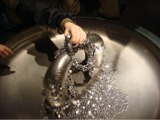
A DC Electromagnet ![]()
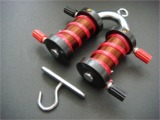
You tin buy this DC electromagnet from Edmund Scientific, P/Northward X31132-00 for almost $15. With information technology, yous can experiment with seeing how much weight it tin hold vs the voltage you apply to the coils. Connect the coils in series, connect them in parallel, use AC or DC voltage. Each coil is rated for 6Vdc. This electromagnet can lift and agree 40 pounds! Accept fun!



camfieldwrecertrecan.blogspot.com
Source: https://www.coolmagnetman.com/magdcem.htm
0 Response to "when an electromagnet has an iron core inserted, what happens to the strength of the magnet?"
Post a Comment